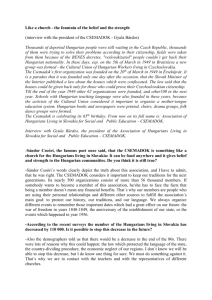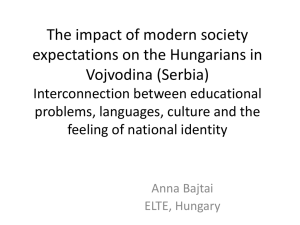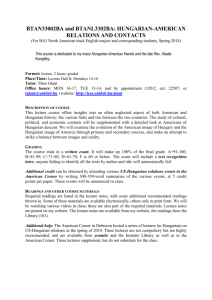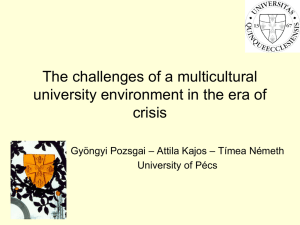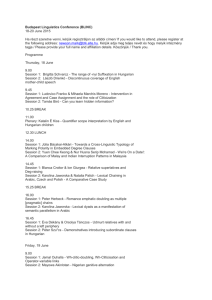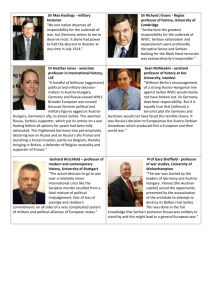Serbia`s Hungarians - Helsinki Committee for Human Rights in Serbia
advertisement
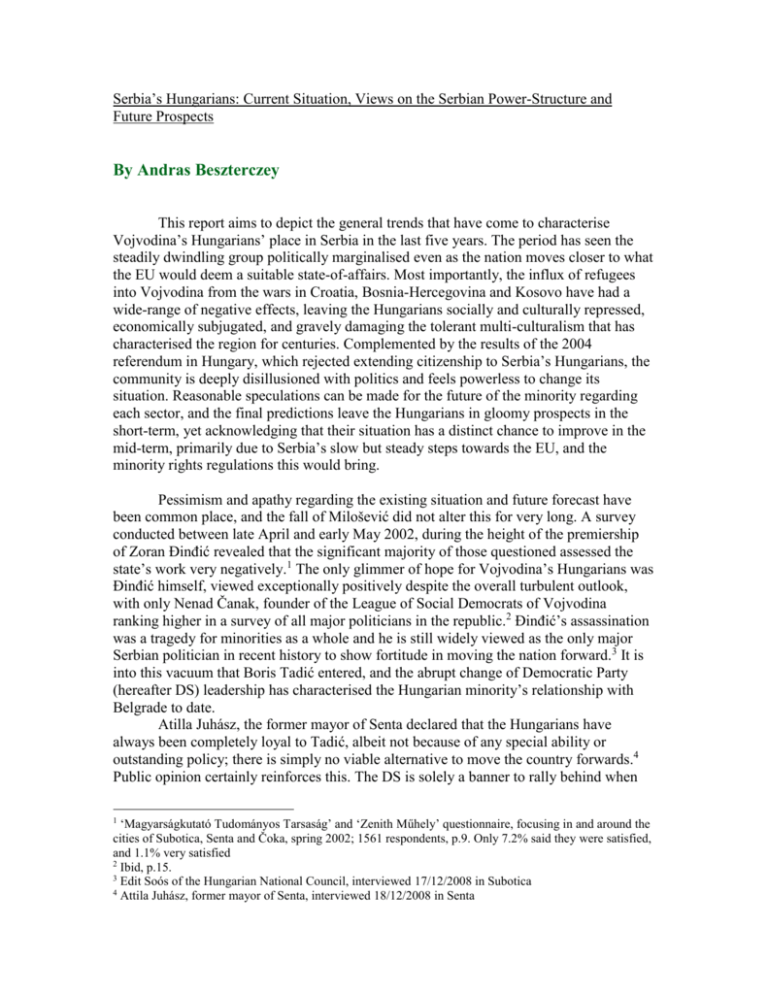
Serbia’s Hungarians: Current Situation, Views on the Serbian Power-Structure and Future Prospects By Andras Beszterczey This report aims to depict the general trends that have come to characterise Vojvodina’s Hungarians’ place in Serbia in the last five years. The period has seen the steadily dwindling group politically marginalised even as the nation moves closer to what the EU would deem a suitable state-of-affairs. Most importantly, the influx of refugees into Vojvodina from the wars in Croatia, Bosnia-Hercegovina and Kosovo have had a wide-range of negative effects, leaving the Hungarians socially and culturally repressed, economically subjugated, and gravely damaging the tolerant multi-culturalism that has characterised the region for centuries. Complemented by the results of the 2004 referendum in Hungary, which rejected extending citizenship to Serbia’s Hungarians, the community is deeply disillusioned with politics and feels powerless to change its situation. Reasonable speculations can be made for the future of the minority regarding each sector, and the final predictions leave the Hungarians in gloomy prospects in the short-term, yet acknowledging that their situation has a distinct chance to improve in the mid-term, primarily due to Serbia’s slow but steady steps towards the EU, and the minority rights regulations this would bring. Pessimism and apathy regarding the existing situation and future forecast have been common place, and the fall of Milošević did not alter this for very long. A survey conducted between late April and early May 2002, during the height of the premiership of Zoran Đinđić revealed that the significant majority of those questioned assessed the state’s work very negatively.1 The only glimmer of hope for Vojvodina’s Hungarians was Đinđić himself, viewed exceptionally positively despite the overall turbulent outlook, with only Nenad Čanak, founder of the League of Social Democrats of Vojvodina ranking higher in a survey of all major politicians in the republic.2 Đinđić’s assassination was a tragedy for minorities as a whole and he is still widely viewed as the only major Serbian politician in recent history to show fortitude in moving the nation forward.3 It is into this vacuum that Boris Tadić entered, and the abrupt change of Democratic Party (hereafter DS) leadership has characterised the Hungarian minority’s relationship with Belgrade to date. Atilla Juhász, the former mayor of Senta declared that the Hungarians have always been completely loyal to Tadić, albeit not because of any special ability or outstanding policy; there is simply no viable alternative to move the country forwards.4 Public opinion certainly reinforces this. The DS is solely a banner to rally behind when ‘Magyarságkutató Tudományos Tarsaság’ and ‘Zenith Műhely’ questionnaire, focusing in and around the cities of Subotica, Senta and Čoka, spring 2002; 1561 respondents, p.9. Only 7.2% said they were satisfied, and 1.1% very satisfied 2 Ibid, p.15. 3 Edit Soós of the Hungarian National Council, interviewed 17/12/2008 in Subotica 4 Attila Juhász, former mayor of Senta, interviewed 18/12/2008 in Senta 1 the reign of nationalists loom, always voted for only in the second round of elections. A survey conducted in March 2004 – a month after Tadić became the leader of the DS – reveals his party to be the third most popular, after G17+ and the local Hungarian VMSZ.5 Yet this must be primarily attributed to the legacy of Đinđić. When directly questioned as to their opinions on Tadić, slightly under a third of respondents either had no opinion of him, or had never heard of him.6 He is the replacement everyone has come to tacitly accept and unenthusiastically support. Correspondingly there has been a decline in interest and involvement in national, or indeed even regional politics, as a 2007 survey found widespread apathy.7 This trend has been facilitated by numerous actions of the state, most recently the alliance with the Socialists Party (hereafter SPS), many of whose members have remained since Milošević was their leader. Hungarians across Serbia view this as an unparalleled betrayal: forming a partnership with the people who conscripted so many Hungarians to fight in a series of wars which involved them in no way shape or form. A local leader amongst the Hungarians who have remained in Novi Sad explains that it has been especially difficult to mobilise people to vote even in the national elections of late, and the new DS – SPS alliance will make this infinitely harder. Another action that has caused the further disillusionment of the Hungarians, widening the gulf between DS campaign promises and reality is the loss of the office of the mayor of Subotica. Hitherto the incumbent has always been a Hungarian, and its loss is acute as the city is the last bastion of the Magyars in Serbia, both physically and metaphorically. Many blame Tadić for not having the understanding to not recognise this small gesture. However, these upsets are nothing new for the Hungarians. Jenő Hajnal, the director of a Senta-based association for the development of Hungarian culture and education, states that, in his constituency at least, the population have become accustomed to expect little. Tadić’s pro-EU foreign policy which guarantees moves towards the protection of minorities and the end of economic isolation is the crux issue why he is supported. Indeed besides certain hindrances, such as losing Subotica, DS foreign policy has brought some specific results in the domestic sphere, for example the position and mandate of the Ministry of Human and Minority Rights has been strengthened. Ironically, one source of optimism is coming from the Serbian Radical Party (hereafter SRS) and the mid-September break between Tomislav Nikolić and Vojislav Šešelj. There are a number of various interpretations of its causes, from tangible evidence that the chauvinistic and exclusionary nationalism as a mass movement – come to personify Serbia abroad in the last two decades – is approaching its end.8 Others see the same power-hungry motivation behind Nikolić’s actions and a nationalism ‘wrapped in ‘Magyarságkutató Tudományos Tarsaság’ and ‘Vajdasági Ifjúsági Forum’ questionnaire of March 2004: 4125 respondents, p.11. 6 ‘Magyarságkutató Tudományos Tarsaság’ questionnaire focusing around Hungarian settlements in Northern Vojvodina, 2004: 4125 respondents, p.32. 7 ‘Magyarságkutató Tudományos Tarsaság’ questionnaire in the Baćka and Banat regions, 2007: 380 respondents, p.64. On a scale of 1 to 5, 1 being not at all interest and 5 being very interested, 34% chose option 1, and 23.8%, 29.7%, 8.0% and 4.5% represent options 2 through 5 respectively 8 Dr Irén Gábrity Molnár, Director, Scientific Association for Hungorology Research, interviewed 19/11/2008 in Subotica 5 silk rather than the newspaper of Šešelj’s wartime variation’;9 however, what there seems to be a consensus on is that the break will inhibit the plans of either right-wing leader to gain the presidency or premiership in the near future, allowing the minorities a little breathing space, the first in years. What is causing tremors throughout Vojvodina – seemingly unnoticed in Belgrade – is the demographic issue. That the number of Hungarians is steadily dwindling is nothing new and has been the case for decades; however, what is new and alarming is the massive influx of wartime refugees who are not leaving, the vast majority of whom are Serbs. As of 2002 Hungarians made up 14.5% of Vojvodina’s inhabitants, compared to its 65% Serb, and down from 16.9% and 57.2% in 1991, and 18.9% and 54.4% in 1981 respectively.10 As these numbers show, the wars did not induce a significantly greater number of Hungarian flee; however, it did cause the steadily increasing Serb population to dramatically enlarge. This in itself is not the problem; it is the nature of the refugees that creates apprehension. Besides being radicalised through their experiences in the Krajina, Bosnia or Kosovo, there is a strong general consensus amongst Hungarians that this ‘war generation’ – especially the Serbian émigrés from the Krajina – were very hostile, assuming that the historically more docile Hungarian communities were as antiSerbian as the Albanians or Croatians. They were completely intolerant, uncompromising and suspicious.11 These ideas have tangible results on the streets; primarily that the younger generation inter-mix less across their daily life, from classrooms to nightclubs. This has had a grave effect on inter-ethnic relations in the region. In their immediate vicinity, Hungarians have few problems with the Serbs. In a 2004 survey in Vojvodina, 65.1% said that they are happy with the situation, and only 14.7% declaring themselves unhappy; however, these numbers begin to significantly change as one moves further into Serbia. When considering Vojvodina as a whole, 23.6% are satisfied, and 39.9% unsatisfied, and when questioned about Serbia in its totality, the results were 10.7% and 66.9% respectively.12 These opinions must not be seen as a ‘one off’. When interviewing Hungarians living in and around Novi Sad, very similar results appeared, with respondents being a little less satisfied with the state of inter-ethnic relations in their immediate vicinity, but very slightly more content in regard to Vojvodina and Serbia.13 It is debateable whether these results only represent growing Hungarian-Serb animosity, or if it is the general breakdown of the inter-ethnic harmony that has become synonymous with the name of the region, at a minimum between the Hungarians and the other ethnic groups. A 2007 study suggests the latter. When questioning Vojvodinian Hungarians about which ethnic group they associate with the easiest in their immediate vicinity, Hungarians proper ranked first. Interestingly Serbs came second by a 9 Teréz Szabó-Hangya, Journalist at Pannon TV, interviewed 17/12/2008 in Subotica Statistical Office of the Republic of Serbia, found at http://webrzs.statserb.sr.gov.yu/axd/en/popis.htm 11 Dr Irén Gábrity Molnár, Director, Scientific Association for Hungorology Research, interviewed 19/11/2008 in Subotica 12 ‘Magyarságkutató Tudományos Tarsaság’ questionnaire focusing around Hungarian settlements in Northern Vojvodina, 2004: 4125 respondents, p.7. 13 Magyarságkutató Tudományos Tarsaság’ questionnaire focusing in and around Novi Sad, June 2004: 1345 respondents, p.15. 10 comfortable majority: 11.9% said they were very friendly with Serbs, and a further 30% felt they had a perfectly amiable relationship and 42.7% of the remainder declaring indifference. Germans came third with 7.7%, 21.3% and 62.9% respectively.14 One possible explanation for these seemingly agreeable opinions of Serbs, but simultaneous erosion of inter-ethnic harmony is of how Hungarians have come to view themselves, and their affiliations. When asked what people and/or place they view as their home, 29% – the majority – declared that it was the Hungarians in their village, 20% Vojvodinians and only 3% said citizens of Serbia.15 As they have been politically repelled and physically pushed further back into Vojvodina and towards the Hungarian border during the wars, they have drawn into their communities for support and protection, heavily aided by events such as their conscription into the JNA to fight in Croatia, and the 2004 referendum in Hungary. Thus, it is not merely that Hungarians have been abused and so rejected Serbs and Serbia, but their identity and personal affiliation have narrowed massively – in-tandem with the wars and their subsequent conscription and the influx of refugees – to the extent that they too are beginning to signify the break with Vojvodina’s past. The 2004 referendum is a very sore point for Vojvodinian Hungarians and a source of serious contention, nigh-universally seen it as a betrayal. For such an individual and emotive issue the results cannot be quantified; however, specific strands of reactions are identifiable. The first of these is the partial rejection of being Hungarian, in particular the narrowing of identity from Hungarian to Vojvodinian Hungarian, a group who seek each other out from Budapest’s universities to London’s cafes.16 This comes with a correspondingly partial rejection of Hungary itself as the referendum also damaged the subjective emotional attachment to the homeland. Before, they had been proud to declare themselves Hungarians, a nation with a similar shared communist past, but one which had subsequently moved forward to join NATO and the EU. This has been dramatically scaled back as the referendum has also lost the Hungarians a certain amount of political clout vis-à-vis Belgrade. The concrete outcome of this has been that the nearly century-old traditions of attending mass at Hungarian Catholic churches and sending children to Hungarian schools will be stopped. In the words of one Hungarian in Novi Sad interviewed, ‘what is the point in all this if your nation-state clearly rejected you?’ Others have decided to raise their children instead as Europeans, and focus on teaching foreign language and not Hungarian history;17 however, this is a common but by no means universal view. Admittedly, for such a debate to be even feasible amongst the population means that Hungarian culture in Vojvodina has outlasted the two Yugoslavias, a world war and three regional conflicts. Some declare that the referendum is still seen as emotionally painful and politically harmful, but will change nothing.18 ‘Magyarságkutató Tudományos Tarsaság’ questionnaire in the Baćka and Banat regions, 2007: 380 respondents, p.19. 15 Ibid, p.68. 16 Dr Irén Gábrity Molnár, Director, Scientific Association for Hungorology Research, interviewed 19/11/2008 in Subotica 17 Edit Soós, Hungarian National Council, interviewed 17/12/2008 in Subotica 18 Attila Juhász, former mayor of Senta, interviewed 18/12/2008 in Senta 14 What there is a universal consensus on is the utter futility of the referendum. Not a single person interviewed said that there would have been any meaningful influx into Hungary of Vojvodinian Hungarians. Precisely as with regard to their culture, Hungarians who are still residing in Vojvodina have stayed there despite the recent wars and economic turmoil, and nothing would induce them to leave. A 2007 survey asking “if you had a completely free choice in the matter, where would you live?” reported that 33.3% said Serbia, 10.8% Vojvodina, and Hungary came fourth with 9.9%.19 A second indicator of this can be found when analysing requests for citizenship. To gain Hungarian citizenship it was compulsory, even for Vojvodinian Hungarians who had attended Hungarian language schools to sit an exam, which was a highly humiliating experience. This was changed only recently, and one may attain Hungarian citizenship if providing proof of the language of education. In her capacity as the headmistress of a Hungarian school in Subotica, Ms Soós has received only five requests from parents for such a certificate, throughout the last two years.20 The refugees are also believed to be the cause of the Vojvodinian Hungarians’ displacement from their leading role in the economic life of the region. The 2002 census which also analysed employment by ethnicity in the province, found the only section of the economy where Hungarians notably predominated was agriculture.21 Correspondingly, financial worries are at the forefront of both personal and national concerns. When questioned ‘in your private life what concerns you the most? 55.4% replied money and 16.6% said unemployment. In your nation: 32% Serbia’s backwardness, 30% slow pace of economic reform, and only 22.2% Vojvodina’s lost autonomy.22 These results were firmly reinforced by another questionnaire of the same year but carried out in Novi Sad.23 It was hoped that once a part of the EU, Hungary and wealth Hungarians would purchase many of the steadily privatised industries in the region, and would employ local Hungarians, offsetting the wave of refugee Serbs being hired at their expense. However, as with the faith in the 2004 referendum, it ultimately proved to be misplaced.24 Some predictions concerning the future for Serbia’s Hungarians are possible. That their numbers will continue to diminish in the short term is assured; however, with interest and investment in Serbia from abroad steadily growing, the nation’s slow but steady overtures to the EU, and Hungary’s dire financial situation, the younger generation’s out-flux may well decrease in the mid term. Yet, no matter how well it is stemmed, in long-term it is difficult to imagine a scenario – other than an economic ‘Magyarságkutató Tudományos Tarsaság’ questionnaire in the Baćka and Banat regions, 2007: 380 respondents, p.11. 20 Edit Soós, Hungarian National Council, interviewed 17/12/2008 in Subotica 21 Statistical Office of the Republic of Serbia, found at http://webrzs.statserb.sr.gov.yu/axd/en/popis.htm 22 ‘Magyarságkutató Tudományos Tarsaság’ questionnaire focusing around Hungarian settlements in Northern Vojvodina, 2004: 4125 respondents, p.17. 23 ‘Magyarságkutató Tudományos Tarsaság’ questionnaire focusing in and around Novi Sad, June 2004: 1345 respondents, p.9. 53.1% lack of money, and 13.9% unemployment for problems in their private life, and 37.5%, 24.1% and 15.0% corresponds to the three categories above for issues in the country. 24 Teréz Szabó-Hangya, Journalist at Pannon TV, interviewed 17/12/2008 in Subotica 19 miracle - where a meaningful number of Hungarians will continue to reside in Serbia over generations. Their political clout will in all likelihood remain negligible in the short-term, and their prosperity will be decided outside of Vojvodina, in Belgrade and the capitals of Europe. Both political and economic power may be given to the Hungarians, but this will fundamentally be done by Belgrade and on its terms. EU influence is the group’s best hope. Their culture has always been strong, and will recover from its recent blows; however, much can depend on the radicalised Serbian refugees who show little willingness to leave. They are unlikely to rapidly harmonise with their non-Serb neighbours, yet there will be no more comparable population flows out of the Serbs remaining in the Krajina, Republika Srspka and Kosovo, and the state’s institutions could well be brought to bear against groups aggressively flying the nationalist flag. Again, with Serbia’s movements towards the EU this will hopefully happen, indeed it is near universally believed by Hungarians that the EU’s main benefit will be peace.25 The task of rebuilding Vojvodina’s society is not solely up to the Serbs, actions of the Hungarians in the last two decades have also had a negative effect. Paramount is the portion of youth who do not speak Serbian to an even marginally sufficient level, in stark contrast to their bilingual parents. It is estimated that only 10% to 15% of Hungarians are attending Serbian schools. Measures have begun to remedy this situation. The Hungarian National Council – with funds from Belgrade and Budapest – has organised a special Serbian school for 750 children to run one year programmes, with very likely increases as funds permit.26 In the political sphere, there is some disillusionment and rejection of ethnic parties as people are beginning to support the DS from the offset, because they believe that this will involving them in Serbian affairs directly, and thus increase their influence.27 If this leads to greater Hungarian contact with Belgrade it can only be a positive asset if the state continues its path towards Europe. These dual initiatives of education and engagement are the best chances for Vojvodina’s Hungarians to regain their former position. The last two decades have shown that if they uncouple themselves from Serbia, they will simply be ignored. Unfortunately, optimism for the future relies heavily upon firstly, Serbia’s economic development – Hungarians are three times more concerned about their financial situation than Vojvodina’s political status28 –, and secondly, the EU’s ability to pull Serbia towards itself using economic ‘carrots.’ The current recession and the institutional stagnation the EU has suffered since the scuttling of the Lisbon Treaty will hinder both undertakings, yet a significant moment is approaching where all sides in the equation, Belgrade, Vojvodina’s Hungarians and EU/US have recognised the role they must play. The DS and it’s pro-Europe foreign policy has been reinforced once again in both parliamentary and presidential elections and the Hungarians are beginning to end their hibernation, teaching their children Serbian and involving themselves directly in Serbia’s political life. Thirdly, a consensus seems to have finally formed in the EU that the recognition of Kosovo or the capture of Ratko Mladić will not be a prerequisite for EU accession. Most ‘Magyarságkutató Tudományos Tarsaság’ questionnaire in the Baćka and Banat regions, 2007: 380 respondents, p.62. The economy ranked second, with half the score of ‘peace.’ 26 Edit Soós, Hungarian National Council, interviewed 17/12/2008 in Subotica 27 Attila Juhász, former mayor of Senta, interviewed 18/12/2008 in Senta 28 See footnotes 22 and 23 25 importantly, the a shift in US policy back to the Balkans is taking place which should bring new momentum for the harmonisation of the region, not to mention financial aid that the EU cannot rival. If these four actors continue their current course, Serbia has a strong chance to end its self-isolation and be in a position to join any and all regional economic, political and security institutions it chooses and in the process draw a great deal of outside investment and rebuild the country to be the leader in the Balkans.
